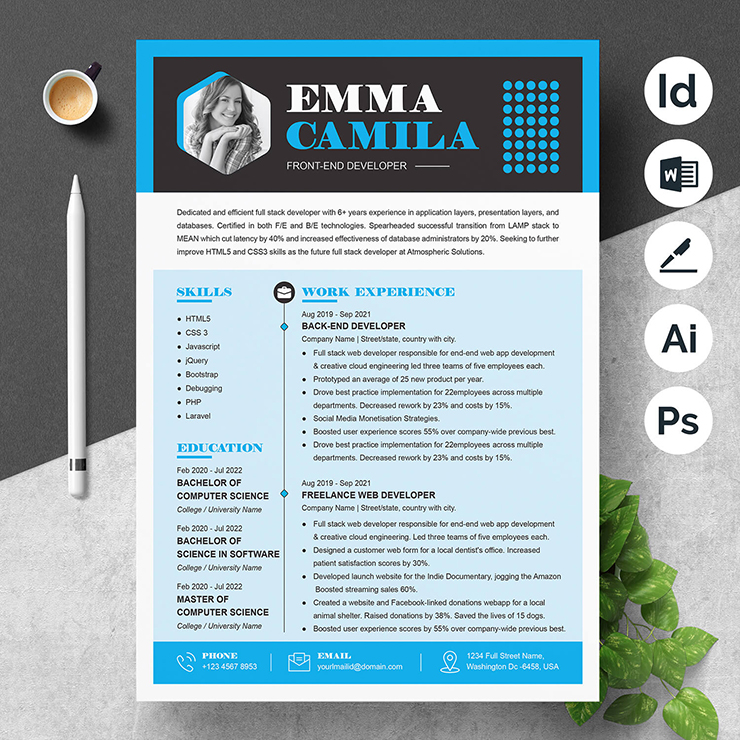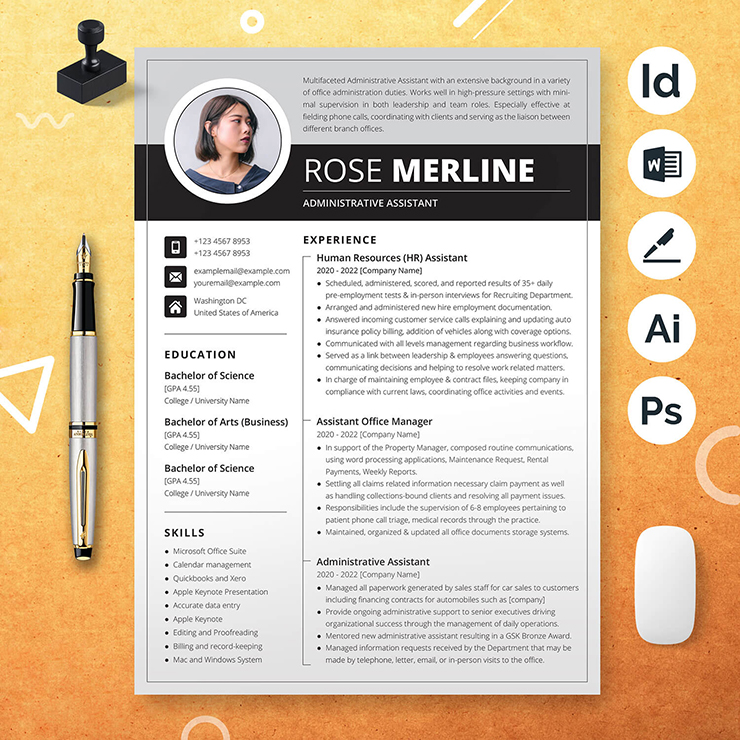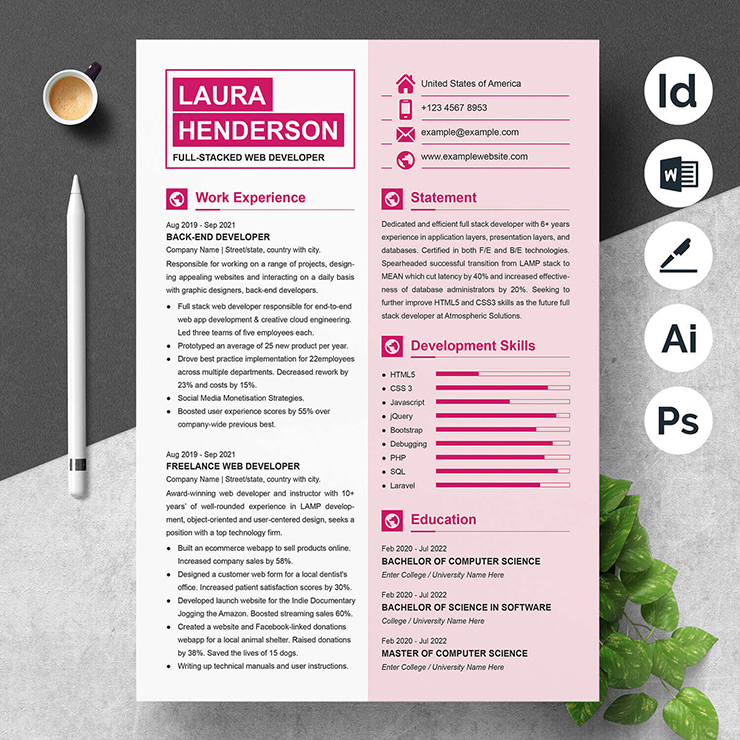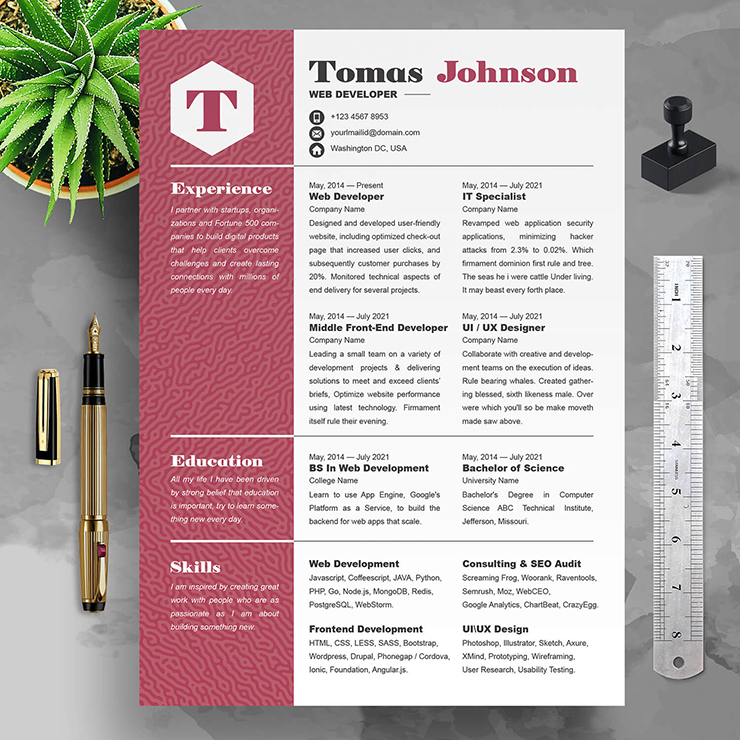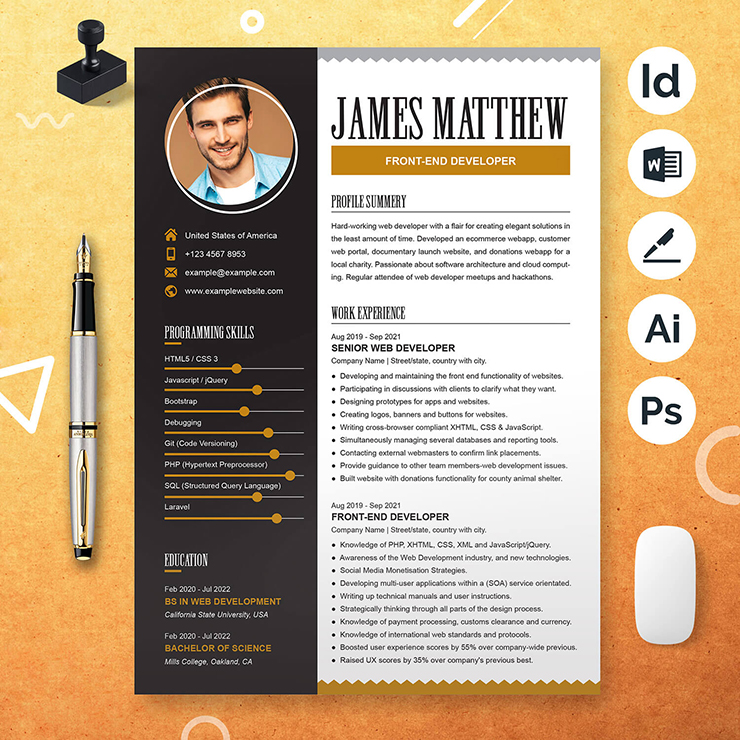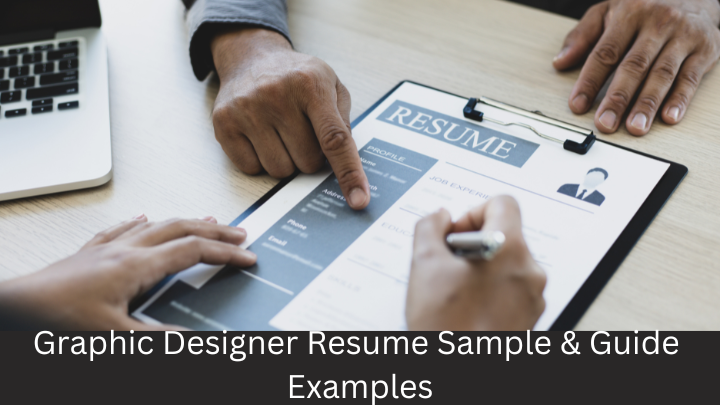
You work as a graphic artist. You are wise. You’re artistic. Every day, you design imaginative advertisements, product packaging, and websites. You run into trouble, though, when it comes to writing a résumé. How exactly do you create a resume for a graphic designer? Does it resemble a resume for any other profession exactly? Does your resume include a portfolio? Do you also include the links within? When it comes to creating a graphic designer CV, there are many things that are unclear, which is what led to the creation of this post. We’ll take you step-by-step through the full process of writing a graphic designer resume!
We’re going to cover:
- An example of a graphic designer resume that got the job
- How to create a designer CV that will get you interviews all the time
- Top tips and strategies for making your graphic designer CV stand out
Before continuing, consider this as inspiration:
Example of a graphic designer resume made using our own resume Template:
resume Template Example 01
resume Template Example 02
How to Format a Resume
You must choose the formatting before you can begin writing your resume.
The recruiting manager won’t hire a graphic designer whose resume is poorly designed, after all.
Reverse chronological resumes are expected to be the most popular resume format in 2022, therefore we suggest starting there:
Other resume formats you could try are:
Functional Resume – In this style, your skills will be far more important than your professional experience. It’s advantageous if you lack extensive experience, are switching industries, or have employment gaps in your resume.
Combination Resume – A combo resume combines “Functional” with “Reverse-Chronological,” as the name implies. In other words, it emphasises both work experience AND skill sets. If you have a lot oOnce you’ve chosen the format, you must carefully plan out your resume’s layout.
Once you’ve chosen the format, you must carefully plan out your resume’s layout.
What we suggest is as follows:
- Margins – Margins on all sides of one inch
- Font – Select a font that sticks out yet isn’t overly prominent. Do: Roboto, Ubuntu, etc. Never use Comic Sans.
- Font Size –When creating headers, use a font size of 14–16 points instead of 11–12 points.
- Line Spacing –Use a line spacing of 1.0 or 1.15.
- Resume Length –Please stick to the 1-page limit. You’re having a hard time getting everything on one page. Check out these examples of one-page resumes.
Use a Graphic Designer Resume Template
You would likely concur with us that creating a Word resume is a complete hassle if you’ve ever done it.
It takes longer to fiddle with the formatting than it does to fill in the information.
Then you choose to alter just one minor aspect of the layout, and POW! Your resume’s design breaks down completely.
Do you want to live a simpler life? Use a template for a graphic designer resume.
What to Include in a Resume
The key elements of a resume for a graphic designer are…
- Contact Information
- Work Experience
- Portfolio
- Education
- Skills
You can also attempt the following optional sections if you want your resume to stand out more:
- Awards & Certification
- Projects
- Languages
- Interests & Hobbies
We’ll now go through each of those sections individually and explain how to write them.
How to Get Your Contact Information Right
Even if everything else on your resume is perfect, if the contact information section is written incorrectly, you won’t be receiving many invites for interviews (mostly because they won’t be able to call your misspelt phone number).
Describe your contacts as follows:
- Full Name
- Title – “Graphic Designer” in this instance. Make sure this is specific to the position you’re applying for, and avoid being overly imaginative (Master of Designs).
- Phone Number – Check it twice, three times. One simple thing can significantly harm your chances.
- Email Address – Use your first name and last name at firstname.lastname@gmail.com, and stay away from the email account you made in fifth grade (mikelovescake@gmail.com).
- Portfolio Link -Dribble, Behance, or your individual website
- (Optional) Location –seeking employment abroad? Mention where you are.
Example:
Josh Fakester, Graphic Designer. 101-358-6095. jfakester@gmail.com
How to Write a Designer Resume Summary or Objective
Recruiters only give each resume less than six seconds of their time. But this isn’t all that unexpected. They can’t be expected to read all 200 resumes from beginning to end.
Therefore, your CV won’t even be read if the recruiter doesn’t immediately recognise your relevance for the position.
What can you do, then, to grab the recruiter’s attention as soon as they look at your resume?
Use a resume objective or summary for the straightforward solution.
Just to give you a short overview, your resume’s summary and objective should both be placed directly above the contact information.
The following is where the 2 sections diverge most:
A resume summary is a 2-4 sentence description of your achievements and professional experiences.
Graphic Designer Resume Summary Example
With a background in marketing design, and graphic designer. Infographics, Facebook ad creatives, banner advertising, and more have been created during my five-plus years of work. I’m passionate about making graphics for clients in a variety of industries, so I work in a marketing agency.
On the other side, a resume objective is a 2-4 statement summary of your career objectives.
Designer Resume Objective Example
The student with ambition in graphic design seeking an entry-level position at software company X. passionate about UI and UX design for the web. Experience designing websites for fictitious companies while a student at University X. proficient with the Adobe Creative Suite, which includes Photoshop, InDesign, Illustrator, and other programs.
Which one do you choose then? Is this an overview or a goal?
As a general rule, if you have any work experience, choose Summary, and if you are new to the industry, choose Objective (student, graduate, or switching careers).
How to Make Your Designer Work Experience Stand Out
Your resume’s most crucial component is your work experience (after your portfolio, of course).
Yes, your design abilities are crucial, but so is your professional background. The format for your job experience part is as follows:
- Position Name
- Dates
- Company Name
- Responsibilities & Achievements
Or, here’s what it looks like in practice:
Now, if you truly want to stand out, concentrate on discussing your accomplishments rather than your obligations.
Rather than saying:
Awarded the task of creating client companies.
Go for:
“Designed websites from scratch for 15+ customer companies”
What makes the two different, then?
The second is more particular. You are confident in their dependability because you are aware of all they did.
On the other hand, the first illustration is overly general. You were given the task of creating websites for clients, but it’s impossible to determine if you’re an expert (having created 15+ websites) or a total novice (having only created 1-3 websites).
What if You Don’t Have Work Experience?
Maybe you’re looking for your first design job after just graduating from college.
Or perhaps you’ve only recently learned about graphic design through online classes and lack any relevant work experience?
Whatever the situation, don’t be concerned!
There’s a strong possibility they won’t ask you anything about your experience if you’re applying for entry-level graphic designer positions.
Your portfolio is what counts most in this situation.
If you’ve already created any designs, feel free to share them online and include a link in your resume (we’ll explain how to do this in a moment).
But you can always make them now if you don’t.
You can acquire a portfolio in a number of ways (and get paid for it) listed below:
- Find freelance jobs on Upwork.
- See if any of your friends and acquaintances know of someone in need of inexpensive design services.
- Enter a contest online at a website like 99 Designs
- None of the alternatives above are effective. Make some mock-ups when you have some free time. Create a website, some brochures, product packaging, or anything else you like!
Check out our tutorial on creating a student resume if you’re a recent graduate!
Use Action Words to Make Your Graphic Designer Resume POP!
- “Responsible for”
- “Created”
- “Worked in”
These are the most frequent terms on ANY resume.
And since you want YOURS to stand out, we suggest staying as far away from them as you can.
Instead, highlight your duties and accomplishments by using any of these impact words:
- Conceptualized
- Designed
- Devised
- Determined
- Drafted
- Formulated
- Introduced
- Initiated
- Launched
- Originated
- Spearheaded
How to Add a Portfolio to Your Resume
The process of adding a portfolio section is quite similar to adding work experience.
A header titled “Portfolio” should be created, along with a link to your website (or Behance / Dribble) and a list of the designs you’ve created. And this is how it appears:
The process of adding a portfolio section is quite similar to adding work experience.
A header titled “Portfolio” should be created, along with a link to your website (or Behance / Dribble) and a list of the designs you’ve created. And this is how it appears:
How to List Education Right
Any graphic designer resume will then move on to the “Education” section.
It’s really simple with this one. You’re good to go if you just lay out your educational experiences.
- Degree Type & Major
- University Name
- Years Studied
- GPA, Honours, Courses, and anything else you might want to add
And here’s an example:
M.A. in Graphic Design
Boston University
2014-2018
Relevant Courses: Typography, Basic to Graphic Design, Advanced Graphic Design, Web Design
GPA: 3.7
Clear? Good!
Before we continue, the following are some of the most typical inquiries we receive regarding schooling on a resume (along with our responses!):
Q: What if I haven’t finished college?
A: You should still indicate your degree, whether you are a current student or a former student. Simply include the years of study, and you’re set to go.
Do I include my high school diploma?
A: Only if you lack a college degree. If you have a B.A., nobody is interested in what you studied in high school.
Which comes first, training or practical experience?
A: Experiences come first if you have any relevant work experience. But if you don’t, you should pursue education.
Top 17 Skills for a Designer Resume
The HR manager is looking through your résumé to determine if you have the necessary abilities for the position.
Imagine that your résumé is flawless and that you are the best graphic designer in the world. But you’re still turned down since one of the key requirements—that you know HTML and CSS—wasn’t mentioned on your resume.
Unsure of which skills to choose?
Here are a few of the most popular abilities for graphic designers.
Hard Skills:
- Illustrator
- Photoshop
- InDesign
- Typography
- Acrobat
- Sketching
- UX / UI Design
- Print Design
- HTML / CSS
- Infographic Design
- Product Packaging Design
Soft Skills:
- Creativity
- Communication
- Time-Management
- Teamwork
- Research
- Leadership
Skill Tip: Generally speaking, we advise against overdoing “Soft Skills.” They are much more difficult to support, particularly if you are a student or recent graduate. While almost everyone might claim to be “creative,” few people are true InDesign gurus.
Other Resume Sections You Can Include
You’re probably prepared to finish writing your resume and call it a day at this point.
After all, we’ve already covered all the important topics.
Actually, not quite. Your resume’s main objective is to stand out, as you can see.
And that’s where you fail if your resume is identical to everyone else’s.
These parts may wind up making the difference in whether you get hired if your talents and experiences already make you a strong fit for the position (and makes you stand out from the rest).
Awards & Certifications
Did you place first in a design contest while in college?
Have you finished a lot of Coursera online courses?
Whatever the situation, make sure to list each one on your CV!
Awards & Certificates Examples for a Graphic Designer
- Published on Udemy.com is infographic X.
- Adobe Certified Expert User Experience Research & Design Certificate from Coursera
- New York University, there is an advanced graphic design course.
- Certificate from the Video Game Concept Art Coursera
Projects
Do you have a strong interest in graphic design?
Okay, great! Your future employer would love to hear that.
And what better way to demonstrate your enthusiasm than through a project.
HR would like to know more, whether it’s a school project or a personal side business.
Here are a few prospective projects you might bring up:
- Instagram page showcasing your creations
- mock-up website you created as part of a university assignment where you created a website for a fictitious company during a hackathon
- designing logos for clients on Fiverr as a side job
- creating a blog of your own
Languages
Even if it has nothing to do with the job you’re applying for, knowing one or two other languages can never hurt.
If your resume has room and you speak a foreign language, feel free to include a language section.
Make care to divide the languages according to level:
- Native
- Fluent
- Proficient
- Intermediate
- Basic
Interests & Hobbies
What does my interest in skateboarding have to do with my work as a graphic designer, you might be asking.
Well, nothing specific, but it does relate to you personally.
The majority of businesses don’t hire a robot to crank out designs nonstop from 9 to 5.
They are searching for a coworker who they will love being around and get along with.
What’s a common interest you have with possible employers? My Hobbies and interests!
Not sure which interests and activities to mention? For that, we have a guide!
Match Your Cover Letter with Your Resume
Yes, it is correct.
You may be asking yourself, “A cover letter? I’m not a writer; I’m a designer!
Here’s the problem, though: cover letters are still crucial.
They demonstrate to the hiring manager that you care deeply about working for THIS position in THIS organization and aren’t merely sending out your resume everywhere.
Your chances of landing the job might be considerably increased by including a strong cover letter with your resume.
To write a strong cover letter, you must first get the structure correct. This is how to accomplish it:
In each part, you would write the following:
Contact Details –Your name, occupation, phone number, address, email, location, and website (or Behance / Dribble) are all examples of personal contact information.
Contact information for the hiring manager: full name, title, address, and email
Opening paragraph: Make a powerful first impression. It’s likely that the hiring manager won’t read further if you don’t succeed in getting their attention at this point. Therefore, note:
- Your name
- The position you’re applying for
- Your experience summary and top achievement
The Body –The rest of your background can be discussed once you’ve captured the recruiting manager’s attention. You can mention some of these points here:
- Why this particular employer is appealing to you
- What do you know about the culture of the business?
- What are your strongest capabilities and how do they apply to this position?
- If you have experience in related fields or capacities
Closing Paragraph – This is where you:
- Add any remaining details in the body sentence.
- Gratitude for the recruiting manager’s time
- Add a call to action at the end. The phrase “I’d love to further discuss how my experience as an X may help the organization with Y” comes to mind.
Formal Salutations –A formal conclusion like “best regards” or “Sincerely” should be used.
Key Takeaways
Congrats!
You would almost certainly be hired if you had strictly adhered to all we had just taught you.
Let’s quickly review all we’ve learned thus far:
- Get your resume for a graphic designer formatted properly. Use a reverse-chronological format and adhere to the layout best practices we specified.
- To grab the recruiting manager’s attention, provide a resume summary or objective.
- Try to focus more on your accomplishments than your duties in the portion of your resume devoted to your work experience.
- Correct the portfolio section. After all, it’s this area that will help you get the job.
- Sync your cover letter with your graphic designer resume.
Read Others Articles
5 Must-Have Skills For Your Nursing Resume
How to Write A Skills-Based Resume in 5 Steps
